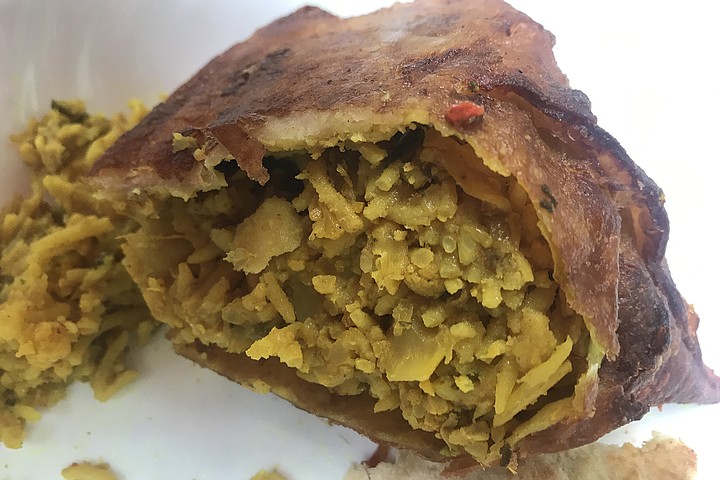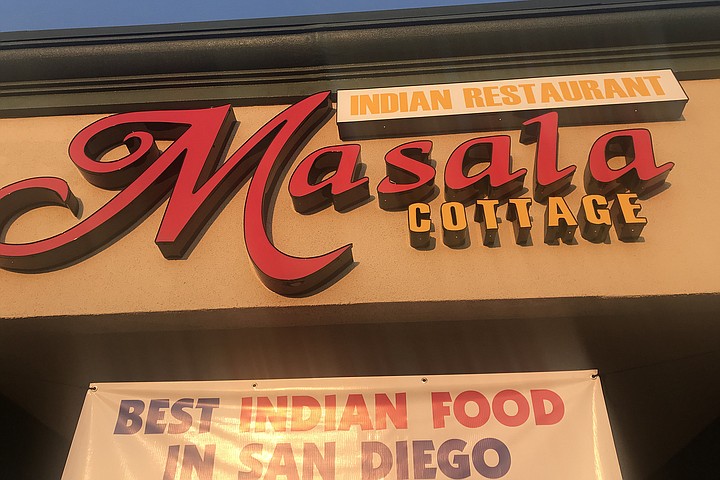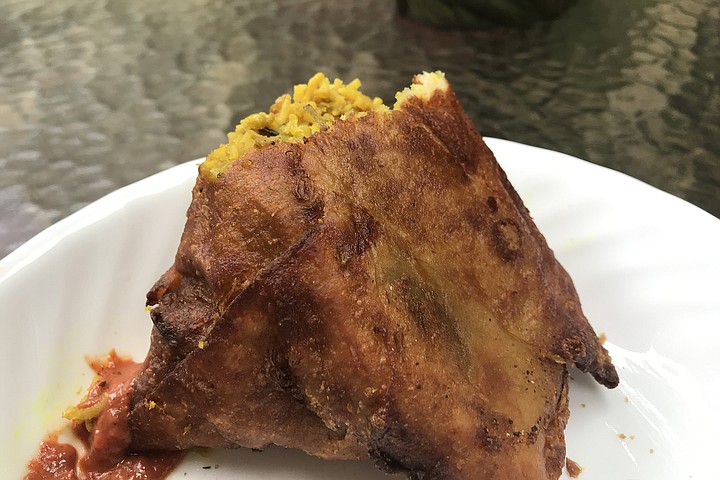 Facebook
Facebook
 X
X
 Instagram
Instagram
 TikTok
TikTok
 Youtube
Youtube

“Dinna fasch yersel,” says Annie (translation: don’t get upset), “but this curry was created in the UK, not India. Scots and Sassanaks (tr: English people) eat more of this than they do fish and chips!”
The Scottish Lady’s talking about this very Indian-tasting chicken tikka masala. And man, national British dish or whatever, it is yummy, creamy, tomatoey, curry tasting, with large chunks of chicken for protein. So-o addictive.
We’re sharing a pot of it ($12 with a separate pot of basmati rice), and some spicy, garlicky naan bread ($4 — the real thing, from a real tandoori oven).

I got all this deliciosity from Masala Cottage — an Indian place on El Cajon Boulevard, 6700 block — and hauled it back to Annie’s place. Good timing! Annie and I fall on it like wolves. And the taste! Ranjit Singh, the chef-owner who cooked it, says the thing about chicken tikka masala is that yes, it is a bona fide curry with coconut, cashew, plus doses of nutmeg, cumin, coriander, and spices like green and black cardamom, even if it also gets dollops of extra cream for the European palate.
“Masala means this mix of spices,” he says. “Tikka means cut up into chunks.”
Whatever, it tastes very Indian to me. And so rich! This basmati rice is really necessary to tamp it down. Then again, we each went to the expense of a cool, golden $6 mango lassi (means “sticky”) drink, to sweeten things up with its deliciosity, and to help the food down.
But our original reason for seeking out the Masala Cottage was the samosas. Annie went online and found out that these triangular wraps are like food ambassadors from the ancient world. They’re fried or baked pastry stuffed with basically anything. You’ll find them from Cairo to Lima to Baghdad to Bangkok. “It says they were made in the triangular shape to imitate the pyramids of Central Asia,” says Annie, “like in Samarkand. And check out that name! ‘Samarkand?’ ‘Samosa?’ Coincidence? We’re aboot to eat history, laddy!”

When I first went in, I got talking to owner Singh. “They call me the King of Samosas,” he said, “because I make over 50 different flavors of them, like nowhere else in the world. And I create them in two sizes. The standard 4-6 ounce, and my very own idea: giant samosas! They’re meal-size, 10-11 ounces. It really does fill you up.”
I check the list. Whew. Lot to get through. Vegan combos like rajma rongi (red kidney beans and black-eyed peas), aloo gobhi (potato and cauliflower), and lots of other vegetarian and vegan samosas, plus chicken, lamb, beef.
These things are so easy to chomp, to take with you. All the food is wrapped inside the pastry shell.

The samosas come with two pots of chutney, mild and spicy, and both, when I try them, are electric adds. Specially with the lamb and the aloo (potato), but also with the saag paneer (cheese and spinach).
Cost-wise, you’re looking at $4-6 for a small one and $8-10 for the large. Trust me, one large is enough. Specially if you add a naan or a pot of the yellow rice.
Turns out Singh spent years in Edinburgh, where Annie’s from. Before that, he spent five years in the Indian Border Security Force. That was a rough life. “We have the longest border in the world. We’re the largest border-guarding force in the world. Pakistan, China, Kashmir, Bangladesh. Trouble spots like Amritsar. I went in on my 18th birthday. We now have Americans with us. We have helped them with training, like with military dogs.”
He was glad to be out of the violence after five years. “I decided I wanted out one time when we tossed grenade after grenade on the roof of this house. We thought there were terrorists inside. In the end, only a woman and children came out. These things happen, but they don’t leave you. A less violent life is better. My mom taught me cooking, and then I started traveling. I have been all over.”
After several careers, he found his rhythm here in San Diego. This is where he’s been crowned “Samosa King” among his fellow Indian-American business people.
“I now have pop-ups in 12 farmers markets,” he says. “And that’s a reduction. Before Covid, I was in 22.”
So I get back to Annie, and lay out the little stack of samosas in a row. I can’t help thinking of those Central Asian pyramids — the ones nobody pays attention to — and how they inspired the shape and heck, usefulness of these edible miniatures. ’Course, samosas are kind of new here, but, like empanadas, pupusas, burritos, you know these little pastry-wrapped triangles are on their way to, as Annie would say, “wurrld-wide dominance.”
So we split the large aloo gobhi (potato and cauliflower) samosa, the lamb samosa, and the saag paneer samosa (spinach and cheese cooked in grapeseed oil), douse them with curry sauce and chutney, and set to. Super-delish, but with this big size, they’re just too much. And this little exercise has cost maybe $40.
“Dinna fasch yersel,” says Annie, “but next time, don’t throw your money around. Order the small ones! Remember, a light purse is a heavy curse.”


“Dinna fasch yersel,” says Annie (translation: don’t get upset), “but this curry was created in the UK, not India. Scots and Sassanaks (tr: English people) eat more of this than they do fish and chips!”
The Scottish Lady’s talking about this very Indian-tasting chicken tikka masala. And man, national British dish or whatever, it is yummy, creamy, tomatoey, curry tasting, with large chunks of chicken for protein. So-o addictive.
We’re sharing a pot of it ($12 with a separate pot of basmati rice), and some spicy, garlicky naan bread ($4 — the real thing, from a real tandoori oven).

I got all this deliciosity from Masala Cottage — an Indian place on El Cajon Boulevard, 6700 block — and hauled it back to Annie’s place. Good timing! Annie and I fall on it like wolves. And the taste! Ranjit Singh, the chef-owner who cooked it, says the thing about chicken tikka masala is that yes, it is a bona fide curry with coconut, cashew, plus doses of nutmeg, cumin, coriander, and spices like green and black cardamom, even if it also gets dollops of extra cream for the European palate.
“Masala means this mix of spices,” he says. “Tikka means cut up into chunks.”
Whatever, it tastes very Indian to me. And so rich! This basmati rice is really necessary to tamp it down. Then again, we each went to the expense of a cool, golden $6 mango lassi (means “sticky”) drink, to sweeten things up with its deliciosity, and to help the food down.
But our original reason for seeking out the Masala Cottage was the samosas. Annie went online and found out that these triangular wraps are like food ambassadors from the ancient world. They’re fried or baked pastry stuffed with basically anything. You’ll find them from Cairo to Lima to Baghdad to Bangkok. “It says they were made in the triangular shape to imitate the pyramids of Central Asia,” says Annie, “like in Samarkand. And check out that name! ‘Samarkand?’ ‘Samosa?’ Coincidence? We’re aboot to eat history, laddy!”

When I first went in, I got talking to owner Singh. “They call me the King of Samosas,” he said, “because I make over 50 different flavors of them, like nowhere else in the world. And I create them in two sizes. The standard 4-6 ounce, and my very own idea: giant samosas! They’re meal-size, 10-11 ounces. It really does fill you up.”
I check the list. Whew. Lot to get through. Vegan combos like rajma rongi (red kidney beans and black-eyed peas), aloo gobhi (potato and cauliflower), and lots of other vegetarian and vegan samosas, plus chicken, lamb, beef.
These things are so easy to chomp, to take with you. All the food is wrapped inside the pastry shell.

The samosas come with two pots of chutney, mild and spicy, and both, when I try them, are electric adds. Specially with the lamb and the aloo (potato), but also with the saag paneer (cheese and spinach).
Cost-wise, you’re looking at $4-6 for a small one and $8-10 for the large. Trust me, one large is enough. Specially if you add a naan or a pot of the yellow rice.
Turns out Singh spent years in Edinburgh, where Annie’s from. Before that, he spent five years in the Indian Border Security Force. That was a rough life. “We have the longest border in the world. We’re the largest border-guarding force in the world. Pakistan, China, Kashmir, Bangladesh. Trouble spots like Amritsar. I went in on my 18th birthday. We now have Americans with us. We have helped them with training, like with military dogs.”
He was glad to be out of the violence after five years. “I decided I wanted out one time when we tossed grenade after grenade on the roof of this house. We thought there were terrorists inside. In the end, only a woman and children came out. These things happen, but they don’t leave you. A less violent life is better. My mom taught me cooking, and then I started traveling. I have been all over.”
After several careers, he found his rhythm here in San Diego. This is where he’s been crowned “Samosa King” among his fellow Indian-American business people.
“I now have pop-ups in 12 farmers markets,” he says. “And that’s a reduction. Before Covid, I was in 22.”
So I get back to Annie, and lay out the little stack of samosas in a row. I can’t help thinking of those Central Asian pyramids — the ones nobody pays attention to — and how they inspired the shape and heck, usefulness of these edible miniatures. ’Course, samosas are kind of new here, but, like empanadas, pupusas, burritos, you know these little pastry-wrapped triangles are on their way to, as Annie would say, “wurrld-wide dominance.”
So we split the large aloo gobhi (potato and cauliflower) samosa, the lamb samosa, and the saag paneer samosa (spinach and cheese cooked in grapeseed oil), douse them with curry sauce and chutney, and set to. Super-delish, but with this big size, they’re just too much. And this little exercise has cost maybe $40.
“Dinna fasch yersel,” says Annie, “but next time, don’t throw your money around. Order the small ones! Remember, a light purse is a heavy curse.”